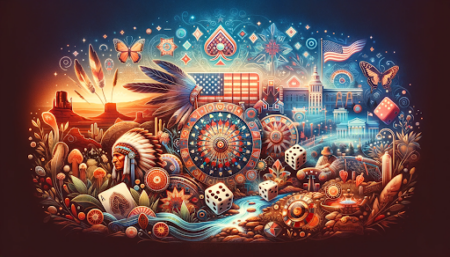26 January 2024
By Roger L Kennedy
roger@TheCork.ie

Entertainment : Delve into the captivating journey of Indian gambling in the United States, spanning ancient traditions to the modern casino landscape
In the US, gambling establishments that are owned by Native American tribes with official federal recognition and that operate on reservations or other tribal territory are referred to as “Indian gaming.” Indian gaming comprises a spectrum of commercial activities, from large casino facilities with slots and Las Vegas-style high-stakes entertainment to smaller establishments providing games like lotteries, bingo, and video poker. Native-owned casinos have certain protection from direct state oversight since U.S. statutes recognize specific kinds of tribal sovereignty and self-government. Nonetheless, tribal gambling businesses must comply with the Indian Gambling Regulatory Act of 1988 and other federal laws.
History of Indian Gambling in the US
The Seminole tribe constructed Florida’s first Indian casino and launched a lucrative high-stakes bingo parlor in 1979. Soon after, other tribes did the same, and by the year 2000, over 150 tribes across 24 states had established bingo or casinos on their reservations. As of 2024, there are 22 tribal casinos in Michigan, 66 in California, 143 in Oklahoma, and hundreds more throughout the nation.
The first few years of the twenty-first century witnessed a sharp increase in income; by 2005, it had surpassed $22 billion annually, with almost 25% of all legal gambling profits in the US coming from Indian gaming. This was considerably less than the 40% share produced by commercial casinos in Nevada, Florida, and New Jersey, but almost the same amount as the nation’s combined state lotteries.
Notably, tribal casinos are required by law to deposit a portion of their yearly earnings to state-controlled trust funds, in contrast to gambling establishments operated by non-Indians. This money is then given to nearby towns to help with expenses associated with the side effects of tribal gaming operations. These include the need for more traffic patrols, treatment for gambling addiction, and the development or upkeep of infrastructure related to transportation, electricity, or sewage systems, among other things. Additionally, a portion of this money is sent to tribes without casinos as aid.
Indian gambling enterprises’ level of profitability is mostly dependent on where they are; those close to or in large cities may be quite lucrative, while those in rural areas, where many reservations are located, generally make considerably less money.
Many Indian casinos have not turned a profit, but tribes who have been profitable with their gambling have been able to utilize the money they earn to enhance the general health, education, and cultural well-being of their people. For example, some platforms like jalwagamee.win have shown how online gaming can provide new avenues for income. Therefore, it is impossible to extrapolate the success of certain activities on a few reservations to all casinos or all reservations. Quite the opposite, U.S. census statistics regularly show that the legalization of Indian gambling has had no overall impact on the Native American population: The most disadvantaged and destitute minority group in the US continues to be Native Americans.
Debate Over Tribal Gambling
Since the late 1970s, political debate has revolved around Indian gambling. Frequently, the discourse has centered on the ethics or immorality of gaming; naturally, this is not a problem exclusive to Indian gaming.
The main issues surrounding Indian gaming operations have generally centered on whether or not tribes should continue to enjoy the special legal status that grants them the ability to own and run these kinds of businesses; and whether or not Indians possess the necessary skills or training to operate these kinds of businesses; whether or not participating in entrepreneurial capitalism undermines indigenous ethnic identities; and whether or not gaming is a desirable addition to a particular local economy.
250312 L
